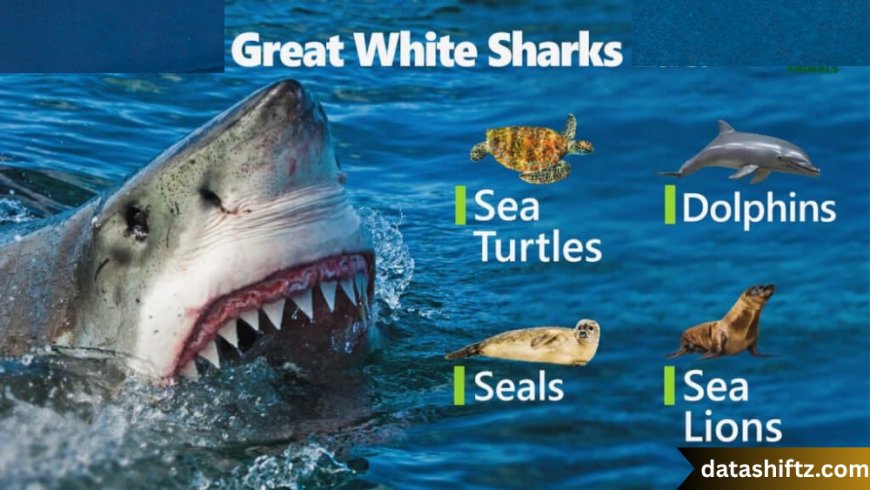Great White Sharks: Kings of the Ocean Depths

Introduction:
The Ocean's Apex Predator
The great white shark (Carcharodon carcharias) is one of the most fascinating and feared creatures in the ocean. Often sensationalized by the media and misunderstood by the public, this apex predator plays a crucial role in maintaining the health of marine ecosystems. Its power, agility, and intelligence have earned it legendary status among marine biologists and ocean enthusiasts alike.
This article explores the world of the great white shark in-depth — from biology and behavior to habitat, threats, and conservation efforts. We’ll also compare it with other shark species, provide factual tables and lists, and dispel some of the most common myths surrounding this iconic creature.
Understanding the Great White Shark
Scientific Classification and Physical Attributes
The great white shark belongs to the Lamnidae family and is one of the largest predatory fish in the world. With a streamlined body built for speed, serrated teeth for tearing flesh, and a sixth sense for detecting electrical fields in the water, it is truly an evolutionary marvel.
| Attribute | Details |
|---|---|
| Scientific Name | Carcharodon carcharias |
| Family | Lamnidae |
| Average Length | 4 to 6 meters (13 to 20 feet) |
| Weight | Up to 1,100 kg (2,400 pounds) |
| Lifespan | 30 to 70 years |
| Top Speed | Up to 35 mph (56 km/h) |
| Diet | Seals, fish, dolphins, carrion |
Anatomy and Sensory Capabilities
Great white sharks possess specialized adaptations that make them exceptional hunters:
-
Ampullae of Lorenzini: Sensory organs that detect electrical impulses from prey.
-
Keen sense of smell: Can detect blood in the water from miles away.
-
Lateral line: A row of sensory cells that detect movement and vibration in the water.
-
Powerful jaws: Capable of exerting a bite force of over 1.8 tonnes (4,000 lbs).
Behavior and Life Cycle
Hunting and Feeding Patterns
Great whites are opportunistic feeders and use a strategy known as ambush predation. They often attack from below, delivering a powerful, surprise blow to their prey. This is commonly observed in places like Seal Island in South Africa, where sharks breach out of the water in spectacular displays.
Feeding Habits List:
-
Target prey includes seals, sea lions, fish, rays, and smaller sharks.
-
They scavenge whale carcasses and fish offal.
-
Young sharks tend to feed on fish and rays before shifting to marine mammals as they grow.
-
Feeding frequency is low; one large meal can sustain them for weeks.
Reproduction and Maturity
Great white sharks are ovoviviparous, meaning embryos develop inside eggs within the mother’s body and are born live.
-
Gestation Period: Around 11 to 18 months
-
Litter Size: Typically 2 to 10 pups
-
Birth Size: About 1.2 to 1.5 meters long
-
Maturity Age: 15 years for males, 20 years for females
Pups are born fully equipped to survive on their own and often leave their birth area to avoid being eaten by adult sharks.
Habitats and Global Distribution
Where Do Great White Sharks Live?
Great whites are found in temperate and subtropical oceans around the world, with concentrations in coastal and offshore waters.
| Region | Notable Areas |
|---|---|
| North America | California, Mexico (Guadalupe Island) |
| South Africa | Gansbaai, False Bay |
| Australia and New Zealand | Neptune Islands, Stewart Island |
| Mediterranean Sea | Rare, but present |
| South America | Chile, Argentina |
Preferred Environmental Conditions
Great whites prefer water temperatures between 12°C to 24°C (54°F to 75°F). They are most active in areas rich in prey, including seal colonies and whale migration routes.
They are known to frequent shallow coastal areas as well as deep open waters, making them versatile and wide-ranging.
Human Interaction and Misconceptions
Are Great White Sharks Dangerous to Humans?
While they are responsible for the most unprovoked shark attacks on humans, these incidents are rare and often not fatal. Many attacks are cases of mistaken identity, where surfers or swimmers are mistaken for seals.
Common Myths vs. Facts
| Myth | Reality |
|---|---|
| Sharks actively hunt humans | False – Humans are not part of their diet |
| All shark bites are fatal | False – Most are survivable if treated promptly |
| Sharks are mindless killers | False – They are intelligent, curious, and often avoid conflict |
| Culling protects beaches | False – No scientific evidence supports this strategy |
Conservation Status and Threats
The great white shark is listed as Vulnerable on the IUCN Red List.
Primary Threats:
-
Bycatch in commercial fishing nets
-
Targeted hunting for fins, teeth, and jaws
-
Habitat degradation
-
Climate change impacting prey distribution
-
Shark tourism if not properly regulated
Although protected in several countries, enforcement remains inconsistent.
Conservation Efforts and Future Outlook
International Protection Measures
| Initiative/Policy | Details |
|---|---|
| CITES Appendix II | Regulates international trade in great white shark parts |
| IUCN Red List | Classified as Vulnerable globally |
| Marine Protected Areas (MPAs) | Provide refuge in critical habitats (e.g., Neptune Islands, Australia) |
| Tagging and Tracking Programs | Help researchers monitor shark movements and behaviors |
| Education and Awareness Campaigns | Reduce fear, increase understanding, and promote conservation |
What Can We Do to Help?
Protecting great white sharks requires collective effort and sustainable practices.
Ways the Public Can Support Shark Conservation
-
Support marine conservation organizations (e.g., Oceana, Shark Trust)
-
Promote sustainable seafood choices
-
Avoid buying shark products (fins, jaws, liver oil)
-
Educate others about shark importance and facts
-
Advocate for stronger marine protection laws
Conclusion:
The Legacy of the Great White Shark
Great white sharks are not monsters — they are majestic, misunderstood marvels that embody the balance and beauty of our oceans. As apex predators, they play an essential role in maintaining ecological equilibrium by keeping prey populations in check and fostering biodiversity.
Yet they face significant challenges from human activity, fueled in part by fear, misinformation, and commercial exploitation. By advancing research, improving policy, and transforming public perception, we can secure a future where these incredible creatures continue to thrive.
Understanding, respecting, and protecting great white sharks is not just an ecological imperative — it's a testament to how we choose to coexist with nature’s most powerful inhabitants.






























